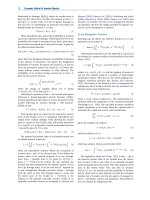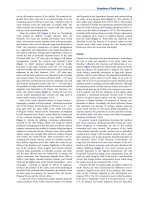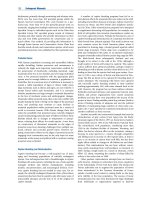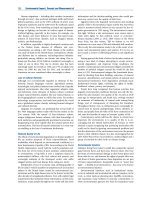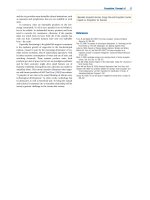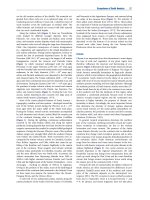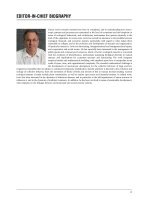Encyclopedia of biodiversity encyclopedia of biodiversity, (7 volume set) ( PDFDrive ) 5148
Bạn đang xem bản rút gọn của tài liệu. Xem và tải ngay bản đầy đủ của tài liệu tại đây (52.33 KB, 1 trang )
514
Glossary
and which may be a part of or connected to a much larger
metacommunity.
Local extinction The fact of a species ceasing to exist in an
area that it had historically occupied.
Local species richness The number of species found at a
local site; distinguished from regional or global species
richness that aggregates the number of species across a
number of individual sites.
Locus (plural loci) The physical location of a gene on a
chromosome.
Logging The operation of harvesting trees, sawing them into
appropriate lengths, and transporting them to a sawmill.
Logistic growth Regulated population growth that follows
the logistic equation dN/dt ¼ rN(1 À N/K). Populations
growing according to this equation increase rapidly at low
densities and the growth rate decreases as they approach
carrying capacity (K).
Lognormal distribution A statistical distribution that is
normal or Gaussian (a bell curve) when the logarithm of the
original data is used. Species abundance data from many
communities fit this distribution well.
Lotka–Volterra competition model A model describing the
per-capita growth rates of two competing species as linear,
declining functions of the abundances of each species.
[Developed independently by the mathematicians Albert J.
Lotka and Vito Volterra.]
LSU rDNA The gene in DNA that codes for the ribosomal
RNA in the large subunit (LSU) of the ribosome. This is 23 S
rRNA in prokaryotes and 28 S rRNA in eukaryotes.
LUE light use efficiency.
Lysogenic A bacterium that has a temperate virus integrated
into its genome. So called because it may lyse (be destroyed or
decomposed) at some later time as a result of the virus
excising from the genome and initiating replication
(induction). This occurs spontaneously with low probability,
or with high probability in response to a stress to the host cell.
Lytic virus A virus that does not integrate into the host
genome, but initiates replication and ultimately lyses the cell.
Ma An abbreviation of the Latin ‘‘mega-annum;’’ used by
paleontologists to indicate dates millions of years before the
present time.
Macroalgae See ALGAE.
Macrobiota Those organisms large enough to be seen with
the naked eye, usually greater than 1 mm.
Macroclimate A generalized climate; see MICROCLIMATE.
Macrocosm A context or system that reflects one of its
components on a large scale.
Macroevolution Evolution leading to the existence of new
species.
Macrofauna Invertebrate organisms living in or on
sediments and large enough to be retained on a 300- or 500mm sieve.
Macroinvertebrate An organism lacking a backbone
(vertebrae) and generally visible to the unaided human eye.
Macroparasite A parasite large enough to be seen with the
naked eye, such as a leech or worm.
Macroplankton A classification of plankton according to
size; those plankton of relatively large size (2–20 cm).
Macropod A marsupial in the family Macropodidae, the
kangaroos and wallabies.
Macropterous Having long or large wings or fins.
Macroscopic Large enough to be visible to the unaided
human eye.
Macrotidal Describing a spring tide range of more than 4 m.
Mafia effect or behavior A term for the fact that hosts have
been observed to tolerate the presence of the eggs or nestlings
of brood parasites rather than ejecting them, because the
parasite can retaliate by destroying the nest entirely. [Likened
to the way citizens will endure the existence of the Mafia in
their community, because any opposition would result in
extreme retaliation.]
Mafic Describing rocks relatively rich in magnesium
and iron.
Major ecosystem type Groups of ecoregions that share
minimum area requirements for conservation, response
characteristics to major disturbance, and similar levels of
biodiversity (i.e., the rate of species turnover with distance).
Malacology The scientific study of mollusks. One who
conducts such studies is a malacologist.
Malesia The Malay Peninsula, Malay archipelago, and New
Guinea. Biogeographically, this combines Sundaland,
Wallacea (including the Philippines), and New Guinea.
Mammal A member of the order Mammalia, including
species that provide milk for their young and have fur or hair.
They typically (but not exclusively) bear live young.
Managed relocation Intentional movement by humans of
organisms from a place where they currently live to a new
region where they are likely to persist in the future, especially
as a strategy to deal with human-caused climate change.
Management The efforts of humans to select, plan, organize,
and implement programs designed to achieve specified goals.
In the context of the natural environment, such activities can
range from protective measures to ensure that human
influences on natural resources are minimized to greater
interventions required to maintain diversity, install facilities,
control populations, and eliminate unwanted elements.
Mangal A mangrove tree habitat, or the trees themselves.
Mangrove 1. Any of various trees and large shrubs, especially
of the genus Rhizophora, that have intertwining aerial roots
and grow densely in salty coastal swamps of tropical and
subtropical regions. 2. An ecosystem dominated by mangroves
and associated vegetation; a unique type of system that is often
the focus of conservation or restoration efforts.
Mantel test A statistical test of the correlation between two
matrices that is often used in ecology; e.g., a geographic and
genetic distance matrix in landscape genetics. [Named for U.S.
statistician Nathan Mantel.]
Mantle In mollusks, an ectodermal tissue layer that secretes
calcium carbonate in the form of spicules or shell.
Maquis Vegetation cover of the Mediterranean Basin
dominated by evergreen sclerophyllous (leathery-leaved)
shrubs and trees.
Marginal value The economic value (marginal benefit or
cost) of the next incremental unit of something. In an
ecological context, marginal values are those associated with
managing the next small unit of an ecosystem in a particular
way (as by preserving, rather than clearing, the next unit of
forest). They can also be the partial contribution of natural
capital to a final good that is produced with other inputs; e.g.,
the marginal value of irrigation water for crop production is
